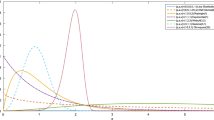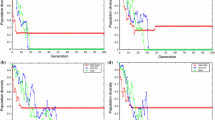Abstract
This paper studied the genetic algorithm (GA) deeply for the problem of hydrological frequency parameter estimation of P-III distribution. For simple GA, the convergence speed and global searching ability are contradictory. An improved algorithm named GA using rejection and interpolation mechanism (GA-RIM) are proposed. Firstly, the rejection mechanism is adopted to ensure the diversity of population and avoid useless operations. Secondly, the strategy of preserving excellent individual is used to guarantee the population to converge to the optimal solution. Thirdly, interpolation mechanism is used to ensure the population to explore in the total domain of definition and mutate adaptively according the diversity of population. The GA-RIM, GA and other four usual methods are used to estimate hydrological parameter of two examples. Through simulation experiments, it was found that the GA-RIM is superior than GA and other methods in terms of convergence speed, precision and global searching ability.





Similar content being viewed by others
References
Lei, G., Wang, W., Yin, J., et al.: Review on study of parameter estimation method on P-III Curve. Yellow Riv. 39(10), 1–7 (2017)
Huang, Z., Lin, X., Hou, Y.: Moment estimation for parameters of Pearson Type-III distribution and calculated frequency of design flood. J. Hohai Univ. (Nat. Sci.) 33(1), 49–51 (2005)
Brighenti, R., Carpinteri, A., Macha, E., et al.: Weight function method for determination of critical plane position under multiaxial loading. Thermochim. Acta 338(s1–s2), 85–94 (2013)
Kawabata, S., Shimizu, Y., Sumino, Y., et al.: Weight function method for precise determination of top quark mass at Large Hadron Collider. Phys. Lett. B 741, 232–238 (2015)
Yuan, X.: Estimation methods of P-III distribution parameter based on partial probability weighted moments. Yangtze Riv. 46(13), 25–28 (2015)
Li, M., Lin, B., Shao, Y., et al.: Study on spatial continuity of precipitation quantile estimates based on regional L-moments analysis. J. China Hydrol. 35(4), 14–19 (2015)
Busababodhin, P., Yun, A.S., Park, J.S., et al.: LH-moment estimation of Wakeby distribution with hydrological applications. Stoch. Env. Res. Risk Assess. 30(6), 1757–1767 (2016)
Ma, H., Zhao, D., Zhu, B.: Comparison of several parameter estimation methods for hydrological frequency curve. Yellow Riv. 38(3), 9–11 (2016)
Noh, S.J., Choi, Y.S., Choi, C.K., et al.: Parameter estimation of a distributed hydrologic model using parallel PEST: comparison of impacts by radar and ground rainfall estimates. J. Korea Water Resour. Assoc. 46(11), 1040–1052 (2013)
Tada, T.: Parameter optimization of hydrological model using the PSO algorithm. J. Jpn. Soc. Hydrol. Water Resour. 20(5), 450–461 (2007)
Kamali, B., Mousavi, S.J., Abbaspour, K.C.: Automatic calibration of HEC-HMS using single-objective and multi-objective PSO algorithms. Hydrol. Process. 27(26), 4028–4042 (2013)
Bowens, C., Dobie, K.H., Devin, C.J., et al.: A model-independent Particle Swarm Optimisation software for model calibration. Environ. Modell. Softw. 43(3), 5–25 (2013)
Wang, W., Lei, G., Liu, C.: Hydrologic frequency analysis using SSO algorithm. J. China Hydrol. 36(3), 34–39 (2016)
Tang, Y., Zhang, Y., Wang, H.: Optimization algorithm of hydrologic frequency parameters based on PSO-AGA. J. Beijing Univ. Technol. 42(6), 953–960 (2016)
Babu, K.: Comparison of PSO, AGA, SA and memetic algorithms for surface grinding optimization. Appl. Mech. Mater. 852, 241–247 (2016)
Shang, X., Dong, W., Hydrosciences, D.O.: Parameter estimation in hydrologic frequency analysis using non-quantitative historical flood and Bayesian approach. J. Hydroelectr. Eng. 34(10), 35–41 (2015)
Wang, W., Lei, G., Liu, H., et al.: The adaptive numerical integral Pearson-III curve parameters estimation based on SSO. J. Basic Sci. Eng. 23(23), 122–133 (2015)
Acknowledgment
The authors acknowledge the National Natural Science Foundation of China (Grant: 61603419), the National Natural Science Foundation of China (Grant: 61771021).
Author information
Authors and Affiliations
Corresponding author
Rights and permissions
About this article
Cite this article
She, W., Li, D., Xia, Y. et al. Parameter estimation of P-III distribution based on GA using rejection and interpolation mechanism. Cluster Comput 22 (Suppl 1), 2159–2167 (2019). https://doi.org/10.1007/s10586-018-2110-6
Received:
Revised:
Accepted:
Published:
Issue Date:
DOI: https://doi.org/10.1007/s10586-018-2110-6




